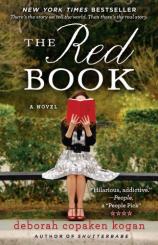Reading Group Guide
Discussion Questions
The Red Book

1. The Red Book is peopled with a broad range of characters. Discuss how successfully you feel the author wrote from the point of view of individuals of so many different social and financial backgrounds, sexual orientations, ethnic identifications, and religious beliefs. Consider, too, that Kogan wrote from the point of view of people of both genders as well as from vastly different generations. Were all of her characters well developed and believable? Was there a character you felt could have been portrayed differently? (And to what purpose?)
2. Both Addison and Mia studied creative arts in college but stopped pursuing their respective fields professionally once they were married and began having kids. Do you feel their stories ring particularly true? Would it have been possible for either one to have led a balanced life while pursuing her passion, and if so, which one(s) and why? Compare their professional trajectories over two decades with those of Jane and Clover, both of whom built successful careers after Harvard. Out of them all, which one, if any, made the wisest decisions and compromises? How large a role did fate, chance, and history (i.e., a massive recession, the shrinking of the newspaper industry) play in each of their narratives, and to that end, how would this book have been different if the author chose to write about the twentieth reunion of the class of 1985? What about the class of 1975?
3. Consider the different biases and aversions these characters have: Bucky’s parents’ racism; Gunner’s anti-Semitism; Mia’s prejudice against Trilby’s angsty teenage appearance; Addison’s aversion to the idea of same-sex couples raising children; Jane’s harsh judgment of Bruno and her mother for their respective infidelities. What kind of comment does The Red Book make about our worst fears, prejudices, and biases and the ways we let them govern our lives? What does it say about the way (and the reasons) we change?
4. Similarly, examine some of the more morally or ethically ambiguous actions taken by the novel’s protagonists: Addison’s willful ignorance of/inattention to $100,000 in parking fines; Gunner’s rampant narcissism and self-centeredness; Clover’s attempt to be impregnated by her married ex-sweetheart; Danny’s inability to empathize or sympathize with Clover during emotionally difficult times; Mia’s rash spending; Jonathan’s one-night stand with his producer; Bruno’s infidelity; Jane’s relatively unforgiving stance with those she loves (at least for most of the novel). What can we learn from these characters about the role morals and ethics play in our lives?
5. While sex is not the only culprit behind the marital discord in these romantic relationships, it plays a large role in the dynamics of its characters’ lives. For instance, Gunner blames much of his distance from Addison on her refusal to sleep with him, while Addison tells herself that she refuses to sleep with him because he won’t help with the child-rearing. Is that the whole story? On the opposite end of the spectrum, Mia and Jonathan --- while troubled, but not irrevocably so --- enjoy a healthy sex life and genuine physical attraction for one another. Consider the way this novel portrays the importance of sex in a long-term relationship, and discuss whether or not the lessons learned by these characters ring particularly true. (And, based on the events in the novel, why?)
6. The Red Book also highlights our human tendency to compare ourselves with peers and to judge the ways and means by which we have lived our lives. The characters in the novel do this every five years via Harvard’s red book, and also through social Web sites like Facebook. What comment is Kogan making about our compulsion to compare ourselves with others? How much do you, like these characters, keep track of what your peers from high school and/or college are doing/accomplishing? What helpful effects, as well as harmful ones, can come from such comparisons?
7. This novel also explores, to some extent, mother-daughter relationships --- through Jane’s grief over her mother’s recent death, Trilby’s dissatisfaction with Addison’s permissive parenting, and Mia’s recollections of her own frustrated mother. Discuss the ways in which Jane’s discovery of her mother’s infidelity challenges Jane’s perception of her mother and marriage in general; the ways in which the sections narrated from Trilby’s point of view avoid typical depictions of teenage rebellion; and the ways in which Mia’s life is both a mirror and a foil to that of her mother’s. What does each relationship reveal about the power, influence, and pitfalls of the mother-daughter connection?
8. Consider Trilby, Thatcher, and Houghton, as well as Max, Eli, and Joshua, and how they represent the marriages that created them. Discuss how Gunner and Addison have damaged their children by avoiding the problems in their marriage, particularly when compared to Mia and Jonathan’s children. Also, think about the ways in which Mia and Jonathan’s children are perhaps less prepared for life’s harder knocks because of the security and lack of family tension in their upbringing. How do you think Eli and Joshua will be affected once their financial and emotional welfare is threatened by Jonathan’s untimely death? In what ways would Trilby, Thatcher, and Houghton be better equipped to handle such tragedy? (Or would they?)
9. While we don’t often find ourselves inhabiting the male perspective in this novel, we do get sections narrated by Max, Jonathan, Bucky, and Bruno. What kind of comment does Kogan make on men and their changing roles as spouses and parents in contemporary times? Consider how Danny and Gunner, who are generally unsupportive of their spouses (and, purposely so, underdeveloped as characters), are representative of a “dying breed” of men, as both find themselves ditched by their wives by the novel’s end.
10. How does the close friendship of Mia, Clover, Addison, and Jane resemble your own close friendships from college and/or high school? What are the redeeming aspects of each character, and what makes them worth following throughout the novel, despite their faults? What part of their friendship is enviable? Is there any part of their friendship that you found unusual, or maybe even unenviable?
The Red Book
- Publication Date: May 7, 2013
- Genres: Fiction
- Paperback: 384 pages
- Publisher: Voice
- ISBN-10: 1401341993
- ISBN-13: 9781401341992








